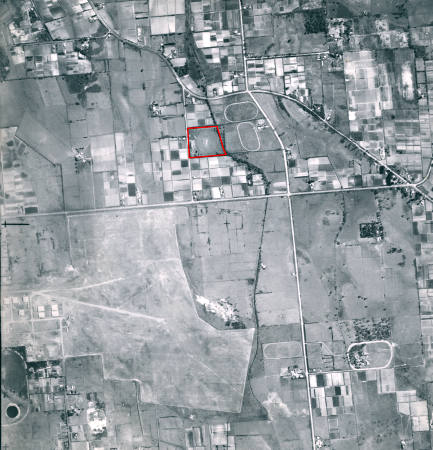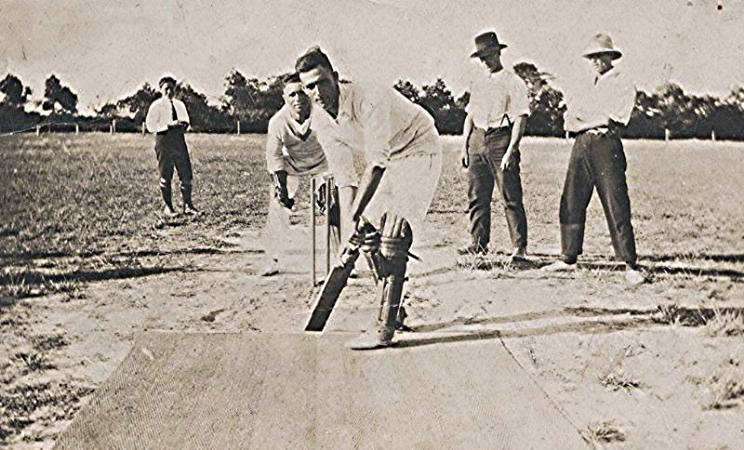The Heatherton Recreation Reserve
Despite having no shopping centre or town centre as most suburbs do, Heatherton has existed as such for more than a century. Originally known as Kingstown and later Kingston, its name came from the covering of bush which graced the area in the mid 1800s when European settlers and particularly the King brothers acquired and grazed the land in 1846.
Lacking what we now know as infrastructure, the community was centred around a church and a common school established in 1868. [1] It was not until quite late in its history that a Progress Association was formed by interested residents about1913. The first President James Hallinan junior and his committee met at Dingley Hall to work toward improving facilities, roads and other aspects of the district.

Heatherton Post Office and General Store 1971. Courtesy Val Dennis, Kingston Collection.
Most residents of Heatherton were attracted to Cheltenham and later Mentone for services such as post offices, banks, churches and shopping as little existed locally. Many of the early families of Heatherton represented sporting teams in these locales too as no fields or facilities were extant.
It was out of this need that a Recreation Reserve was mooted, as a place for sporting activities and gatherings. The site chosen, which remains to this day, was on Ross Street, which runs between Centre and Old Dandenong Roads. The site was formerly a parcel of land acquired by adverse possession by Thomas and Margaret Hallinan, natives of Newcastle, Tipperary, who had arrived in the area in the 1860s. [2] Tom had selected two properties, one of eight and a half acres on Ross Street and another called the ‘dairy paddock’ on the corner of Boundary Road and Old Dandenong Road. The Hallinans were primarily market gardeners but also conducted a dairy. Milk in large cans was taken from the property by cart to Cheltenham station and from there by train to Hallinan’s daughter Grace and son-in-law James Sheridan’s dairy in Caulfield which was situated where Bethlehem Hospital now stands. Following Tom Hallinan’s death in March 1898, the various properties were left to his daughters Kate McClure, Margaret Garvey, Grace Sheridan, Delia later Mrs W J Williams and Annie later Mrs John Andrews Kelly, all of whom had attended Kingston Common School as no Catholic school was close enough at the time.
The portion on which the Reserve now stands was left to Grace Sheridan and Margaret Garvey. Following Margaret Garvey’s premature death aged only in her forties, her half was left to her sister Annie Kelly. Grace Sheridan had no real need to retain her property as it was so far from her home in Caulfield, and eventually sold it at auction to John Kelly’s cousin Ben for £350 around 1912.

Aerial photograph showing Heatherton Reserve along with Centre Dandenong Road, Boundary Road and Old Dandenong Road c1956. Courtesy City of Kingston, Kingston Collection.
Despite having blasted stumps out and prepared the ground for a crop of potatoes with the help of in-laws Pat and Helena Dowling, Ben eventually concluded that it was too far from his other properties further down Centre Dandenong Road, Cheltenham, where Benkel Avenue now stands. Thus, it was seen as an appropriate property for the proposed reserve.
“Whereas on the Eleventh day of August on thousand nine hundred and fourteen, Robert Mills, John Longmuir and Arthur Henry Castle purporting to act on behalf of the residents purchased from Bernard Francis Kelly of Centre Dandenong Road Cheltenham, Market Gardener all that piece of land containing nine acres, three roods and five perches or thereabouts being part of Crown Allotment Three, Section Fifteen, Parish of Mordialloc, County of Bourke, having a frontage of Ross Street, Heatherton and being more particularly described in Certificate of Title Volume 3165, Folio 632830, hereinafter called the land for the price of three hundred and fifty pounds and paying therefore the sum of one hundred and fifty pounds as deposit and the balance within five years from the date of such contract with interest in the meantime at the rate of five pounds per annum”.
Prior to the conclusion of the purchase of the land, Cr White of the Shire Council enquired whether the council would have a permanent representative on the management committee of the reserve given that they had contributed £50 to its purchase. Crs Mills, Shields and Brownfield all indicated interest but informed their colleagues that no such action had taken place at that time. [3]
Some months later a meeting chaired by Cr Mills was held to resolve some difficulties regarding the financial position of the project and the selection of suitable trustees for the property. [4] Initially, after a delay, trustees were appointed but for a variety of reasons several thought fit to resign causing five vacancies. The individuals who resigned were Messrs H Stookes, J Hallinan, H Armstrong and J Kingston. J Longmuir was asked to act as a trustee but declined. Consequently there were five vacancies. These were filled by Cr Mills, Messrs A H Castle, P Kelly, J Parry and W Brownfield. Mr Gartside an earlier appointment also decided to resign and was replace by W Longmuir. Cr G Brownfield was selected to join the management group as the council representative. At the conclusion of the meeting the trustees met and authorized the payment of the £50 deposit and elected executive officers to attend to the proper transfer of the property. The individuals appointed were chairman R Mills, secretary A H Castle, and treasurer J Longmuir.
Attention immediately turned to improving the new reserve. A working bee drew many willing workers including R Mills, H Castle, three Longmuirs, three Kellys, four Brownfields, two Stookes, Armstrong, Harris, Parry, Smith as well as others. They brought with them five drays, six ploughs, five scoops and dozens of shovels to undertake the work. [5] Later in the month, O R Snowball, the local member in the Legislative Assembly informed the community that the Education Department had approved extensions to the Heatherton State School and the old buildings that were not required would be removed. This raised the possibility that they might be obtained by the committee for the new reserve.
In 1923, nine years after the purchase of the property and on the suggestion of a solicitor, much local discussion arose about the possibility of handing the management of the reserve to the Moorabbin Shire Council. A meeting was called by the secretary to the trustees, George Willey, to consider the matter. The newspaper advertisement indicated that C Kelly and others would speak in support of the proposal but acknowledged the trustees were not enamored with the scheme. [6] Opinion was divided. Mr Kelly acknowledged there were various ways of appointing trustees but by handing over the reserve to the council an advantage was gained because the council would always be in existence. This advantage could be achieved, in his view, while reserving for the people the right of management. [7] Mr Brownfield’s advice was ‘to retain complete control. If the place were vested in the council there were those living in Dandenong who were interested and yet would have no say in the management. His experience was that any matter controlled by the council was a failure.’ [8]
C Gartside voiced his opposition both to a committee of management and to trustees. [9] After much debate Mr Parry moved that the meeting affirmed the principle of a local trust with a committee of management. Then followed protracted discussion on the motion. C Gartside moved an amendment that removed reference to a committee of management. But he failed to gain the necessary support. Finally Mr Parry’s motion was agreed to. It was a week later at a second public meeting that Follet, Brownfield, and Parry were elected as trustees. Cr Castle and Messrs Besant, Swallow, Marriott, E Hough, B Kelly and G V Parry were appointed to the committee.
Further local debate ensued later in 1923 about the use of facilities on Sundays. At the time the oval was used for sports such as cricket, football, athletics, and as an arena for the annual carnival. Tennis courts had been constructed in 1920. The question ‘Should games be played on the recreation reserve on Sundays?’ engendered considerable feeling throughout the district through the playing of tennis on the Sabbath. As there was nothing specific in the trust deed about the issue a public meeting was convened in the Recreation Hall to finalize the matter. [10] John Andrews Kelly, one time caretaker and treasurer, whose children were among those playing tennis on Sundays was of the opinion that if his children were playing tennis there, at least he knew where they were. The issue remained unresolved with the community’s attention turning to what were seen as more important issues including the building of a more substantial hall.
From the 1920s various individuals took on the role of trustee, preserving the facility for the use of the local community. In 1979 Douglas Wallace, Geoffrey Burke and Everest Vernon-Le Page were trustees. Five years later Douglas Wallace was reappointed but he was joined by Kevin Smith and Gary Ryan. In 1988 Wallace and Smith were joined by Giancarlo Bellerini. It was early in 2002 when members of the Heatherton Recreational Reserve Trustees commenced discussions with officers of the Kingston Council to explore the possibility of the council taking over responsibility for the reserve.[11] The trustees were concerned that there would be no one to replace them. Detailed discussions followed.

Ray Tilley batting on the Heatherton Recreation Reserve c1920. Note the ‘casual’ dress of fielders and matting on the pitch. Courtesy Barry Tilley, Kingston Collection.
In October 2003 the Trustees indicated that they aimed to have the reserve transferred to the council on the 1 July 2004 but in the meantime asked the council to take over the mowing of the oval and other maintenance of the reserve while they continued to maintain the buildings. This arrangement they saw as allowing them to cease the maintenance of equipment and provide sufficient time to demolish the caretaker’s residence after July 2004. [12] The Council had reservations.
Council officers indicated Council did not want to assume responsibility for the caretaker’s residence, suggesting the trustees should decide whether to demolish the dwelling and remove the rubbish or excise this section of land from the transfer. They also acknowledged that the trustees had proposed, rather than completing substantial works on the reserve before transfer, they would transfer any remaining funds in their account to the Council after they had paid for legal fees, demolition of dwelling and any other outstanding accounts. In addition the Council wanted the Reserve committee incorporated because it was the intention of the council to lease the property to an incorporated body who in turn would manage access to sporting groups. [13]
Discussions between the Trustee’s solicitor and Council continued in June 2004 with the solicitor Alan Splatt indicating that his clients had agonized over some matters proposed by Council. In particular the Trustees were not prepared to modify the Deed of Arrangement to remove the requirement for the Council to hold the property in perpetuity for the stated purpose. Splatt advised the “Council that the land could not be transferred to Council nor the current trust wound up without the consent of the Supreme Court.” However, there was little doubt, in his mind, that the Court will consent to a transfer to Council but only if Council agreed to hold the land as Trustee for the same purposes as the original Trust, namely for it to be held in perpetuity to be used as and reserved for public educational and charitable purposes and for recreation generally in the manner which has been the case since the commencement of the Trust.
Douglas Wallace, Tom Berghella and Kenneth Dunstan, trustees signed the Deed of Agreement in the presence of a councillor and the Acting Chief Executive Officer of council on September 2004. The agreement reflected the wish of the trustees that the land could never be sold and that it be used for recreational, educational and charitable purposes. The Heatherton Reserve then became the responsibility of the City of Kingston.
Footnotes
- See, Alan Bennett & Graham Whitehead, Kingston Common School: Heatherton School No 938, Kingston Historical Website.
- Adverse Possession ‘is an old doctrine that says, basically, that where a trespasser remains in possession of land for a period of time – generally 15 years and 1 day – then that person may have acquired ownership of the land.’ – www.relv.com.au/advposs.asp
- Moorabbin News, 10 October 1914.
- Moorabbin News, 10 October 1914.
- Moorabbin News, 9 June 1923.
- Moorabbin News, 23 June 1923.
- Moorabbin News, 23 June 1923.
- Moorabbin News, 23 June 1923.
- Moorabbin News, 8 December 1923
- Rijs, T., Memorandum: Heatherton Recreational Reserve Trust.
- Correspondence Taylor Splatt Partners; Lawyers.
- Correspondence: Jeanette Blackwood to Alan Splatt 14 April 2004.
